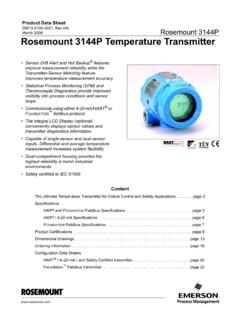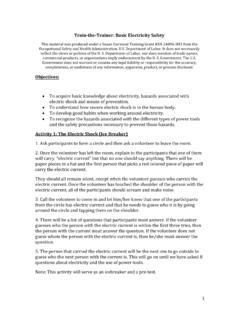Transcription of Battery testing guide - Instrumart
1 testing guide Why backup batteries are needed Battery types Failure modes Maintenance philosophies Practical Battery testing Frequently asked questions Megger products overviewBattery testing GUIDe3 ContentsWhy backup batteries are needed .. 4 Why test Battery systems .. 4 Why batteries fail .. 4 Battery types .. 5 Lead-acid overview .. 5 Nickel-Cadmium Overview .. 5 Battery construction and nomenclature .. 6 Configurations .. 6 Single post batteries .. 6 Multiple post batteries .. 6 Failure modes .. 7 Lead-acid (flooded) failure modes .. 7 Lead-acid (VrLa) failure modes .. 7 Nickel-Cadmium failure modes .. 8 Maintenance philosophies .. 9 How to maintain the Battery .. 9 Standards and common practices .. 9 Ieee 450 .. 9 Inspections .. 9 Capacity test (discharge test) should be done .. 9 Ieee 1188 .. 10 Inspections .. 10 Capacity test (capacity test) should be done .. 10 Battery replacement criteria .. 10 Ieee 1106 .. 10 Inspections.
2 10 Capacity test (discharge test) should be done .. 10 Summary best way to test and evaluate your Battery .. 10test intervals .. 10 Practical Battery testing .. 11 Capacity test .. 11 Battery testing matrix Ieee recommended practices .. 11 Procedure for capacity test of vented lead acid Battery .. 12 Impedance test .. 13 Impedance theory .. 13 Intercell connection resistance .. 14testing and electrical paths .. 15 Voltage .. 15 Specific gravity .. 15 Float current .. 16ripple current .. 16temperature .. 16 Data analysis .. 17 Locating ground faults on DC systems without sectionalizing .. 18 Overview .. 18 Current test methods .. 18a better test method .. 18 Frequently asked questions .. 19 Battery technology summary .. 19 Megger products overview .. 20 Impedance test equipment .. 20 BIte 3 .. 20 BIte 2 and BIte 2P .. 21 Proactiv Battery database management software .. 21 BIte accessories .. 21 Capacity testing .. 23tOrKeL 820/840/860.
3 23tOrKeL accessories .. 23 Ground fault tracing equipment .. 24 Battery Ground Fault tracer (BGFt).. 24 Battery Ground-fault Locator (BGL) .. 24 Digital Low resistance Ohmmeters (DLrO ) and Microhmmeters (MOM) .. 26 DLrO200 and DLrO600 .. 26 DLrO 247000 series .. 26MJ LNer 200 and MJ LNer 600 .. 27 MOM200a and MOM600a .. 27 MOM690 .. 27 Multimeters .. 28 MMC850 Multi-conductor aC Digital Clampmeter .. 28 Multimeters .. 28 Insulation resistance test equipment .. 29 MIt400 series insulation resistance testers .. 294 Battery testing GUIDeWhy backup batteries are neededBatteries are used to ensure that critical electrical equipment is always on. There are so many places where batteries are used it is nearly impossible to list them all. Some of the applications for batteries include: electric generating stations and substations for protection and control of switches and relays telephone systems to support phone service, especially emergency services Industrial applications for protection and control Back up of computers, especially financial data and information Less critical business information systemsWithout Battery back-up hospitals would have to close their doors until power is restored.
4 But even so, there are patients on life support systems that require absolute 100% electric power. For those patients, as it was once said, failure is not an option. Just look around to see how much electricity we use and then to see how important batteries have become in our ev-eryday lives. The many blackouts of 2003 around the world show how critical electrical systems have become to sustain our basic needs. Batteries are used extensively and without them many of the services that we take for granted would fail and cause innumerable test Battery systemsThere are three main reasons to test Battery systems: to insure the supported equipment is adequately backed-up to prevent unexpected failures by tracking the Battery s health to forewarn/predict deathAnd, there are three basic questions that Battery users ask: What is the capacity and the condition of the Battery now? When will it need to be replaced? What can be done to improve / not reduce its life?
5 Batteries are complex chemical mechanisms. They have numerous components from grids, active material, posts, jar and cover, etc. any one of which can fail. As with all manufacturing processes, no matter how well they are made, there is still some amount of black art to batteries (and all chemical processes). A Battery is two dissimilar metallic materials in an elec-trolyte. In fact, you can put a penny and a nickel in half of a grapefruit and you now have a Battery . Obviously, an industrial Battery is more sophisticated than a grapefruit Battery . Nonetheless, a Battery , to work the way it is sup-posed to work must be maintained properly. A good Battery maintenance program may prevent, or at least, reduce the costs and damage to critical equipment due to an AC mains thought there are many applications for batteries, standby batteries are installed for only two reasons: to protect and support critical equipment during an aC outage to protect revenue streams due to the loss of serviceThe following discussion about failure modes focuses on the mechanisms and types of failure and how it is possible to find weak cells.
6 Below is a section containing a more detailed discussion about testing methods and their pros and batteries failIn order for us to understand why batteries fail, unfortu-nately a little bit of chemistry is needed. There are two main Battery chemistries used today lead-acid and nickel-cad-mium. Other chemistries are coming, like lithium, which is prevalent in portable Battery systems, but not stationary, invented the primary (non-rechargeable) Battery in 1800. Plant invented the lead-acid Battery in 1859 and in 1881 Faure first pasted lead-acid plates. With refine-ments over the decades, it has become a critically important back-up power source. The refinements include improved alloys, grid designs, jar and cover materials and improved jar-to-cover and post seals. Arguably, the most revolutionary development was the valve-regulated development. Many similar improvements in nickel-cadmium chemistry have been developed over the testing GUIDe5 Battery typesThere are several main types of Battery technologies with subtypes: Lead-acid Flooded (wet): lead-calcium, lead-antimony Valve regulated Lead-acid, VrLa (sealed): lead-calcium, lead-antimony-selenium absorbed Glass Matte (aGM) Gel Flat plate tubular plate Nickel-cadmium Flooded Sealed Pocket plate Flat plateLead-acid overviewThe basic lead-acid chemical reaction in a sulphuric acid electrolyte, where the sulphate of the acid is part of the reaction, is:PbO2 + Pb + 2H2SO4 2 PbSO4 + 2H2 + 1 2 O2 The acid is depleted upon discharge and regenerated upon recharge.
7 Hydrogen and oxygen form during discharge and float charging (because float charging is counteracting self-discharge). In flooded batteries, they escape and water must be periodically added. In valve-regulated, lead-acid (sealed) batteries, the hydrogen and oxygen gases recombine to form water . Additionally, in VRLA batteries, the acid is immo-bilized by an absorbed glass matte (AGM) or in a gel. The matte is much like the fibre-glass insulation used in houses. It traps the hydrogen and oxygen formed during discharge and allows them to migrate so that they react back to form water . This is why VRLA never need water added compared to flooded (wet, vented) lead-acid Battery has alternating positive and negative plates separated by micro-porous rubber in flooded lead-acid, absorbed glass matte in VRLA, gelled acid in VRLA gel batteries or plastic sheeting in NiCd. All of the like-polarity plates are welded together and to the appropriate post.
8 In the case of VRLA cells, some compression of the plate-matte-plate sandwich is exerted to maintain good contact between them. There is also a self-resealing, pressure relief valve (PRV) to vent gases when over-pressurization OverviewNickel-Cadmium chemistry is similar in some respects to lead-acid in that there are two dissimilar metals in an electrolyte. The basic reaction in a potassium hydroxide (alkaline) electrolyte is:2 NiOOH + Cd +2 H2O Ni(OH)2 + Cd(OH)2 However, in NiCd batteries the potassium hydroxide (KOH) does not enter the reaction like sulphuric acid does in lead-acid batteries. The construction is similar to lead-acid in that there are alternat-ing positive and negative plates submerged in an electrolyte. Rarely seen, but available, are sealed NiCd testing GUIDeFigure 1 Battery construction diagramBattery construction and nomenclatureNow that we know everything there is to know about Battery chemistry, except for Tafel curves, ion diffusion, Randles equivalent cells, etc.
9 , let s move on to Battery construction. A Battery must have several components to work properly: a jar to hold everything and a cover, electrolyte (sulphuric acid or potassium hydroxide solution), negative and positive plates, top connections welding all like-polarity plates together and then posts that are also connected to the top connections of the like-polarity batteries have one more negative plate than positive plate. That is because the positive plate is the working plate and if there isn t a negative plate on the outside of the last positive plate, the whole outer side of last positive plate will not have anything with which to react and create electricity. Hence, there is always an odd number of plates in a Battery , , a 100A33 Battery is comprised of 33 plates with 16 positive plates and 17 negative plates. In this example, each positive plate is rated at 100 Ah. Multiply 16 by 100 and the capacity at the 8-hour rate is found, namely, 1600 Ah.
10 Europe uses a little different calculation than the US batteries that have higher capacities, there are frequently four or six posts. This is to avoid overheating of the cur-rent-carrying components of the Battery during high current draws or lengthy discharges. A lead-acid Battery is a series of plates connected to top lead connected to posts. If the top lead, posts and intercell connectors are not sufficiently large enough to safely carry the electrons, then overheating may oc-cur (i2R heating) and damage the Battery or in the worst cases, damage installed electronics due to smoke or prevent plates from touching each other and shorting the Battery , there is a separator between each of the plates. Figure 1 is a diagram of a four-post Battery from the top looking through the cover. It does not show the come in various configurations themselves. Add to that the many ways that they can be arranged, the number of possible configurations is endless.
















